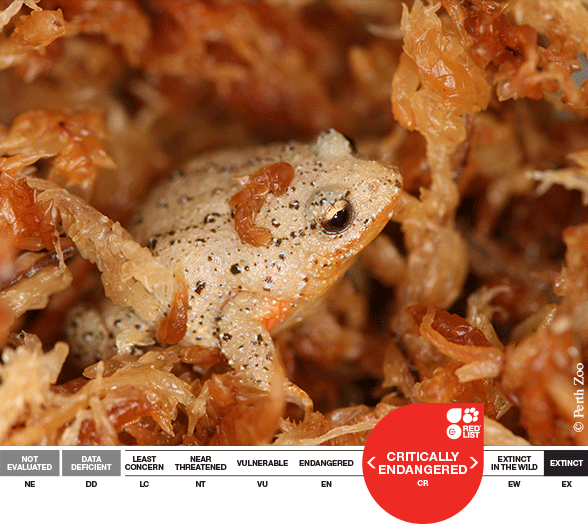
Geocrinia alba, the White-bellied Frog, is considered ‘Critically Endangered’ on the IUCN Red List of Threatened Species. It is native to southwest Australia, residing between Blackwood and Margaret River. It occurs in Leeuwin-Naturaliste National Park, Forest Grove and Witchcliffe State Forests, as well as private land. The range of this species is 130 km2 but the area of occupancy is only 2.5 km2. The White-bellied Frog lives in permanently moist, swampy areas in drainage depressions. It breeds in spring and early summer and the females lay eggs in burrows. The eggs develop directly with no tadpole stage.
The current estimate in the wild is around 50 populations, most with less than 20 individuals (10 calling males). The total population is around 3,000 individuals. From genetic studies and mark and recapture studies, it seems that the different populations of White-bellied Frogs do not interbreed or travel far from their native swamps. Thus, there is high genetic diversity between populations, so extinction of any single population is a significant loss to the White-bellied Frog species.
Much of the land (80%) occupied by this species is privately owned. This makes it especially hard to introduce and implement conservation measures and has also lead to range fragmentation. An estimated 70% of breeding site streams in the region have been cleared and 31% of the sub-populations have gone extinct since the species was discovered in 1983. The three main threats that have led to a decline in White-bellied Frogs are historical habitat loss through clearing for agriculture, habitat disturbance by cattle grazing and altered hydrological regimes through modified surface drainage and water impoundments (dams). In recent times reduced rainfall, extended drought periods have contributed to further habitat decline and population loss. The potential for large scale ground-water abstraction in response to a drying climate remains a significant threat.
In the national park and state forests where White-bellied Frogs are found, measures are in place to conduct annual population surveys. Perth Zoo has been managing a captive population of this species since 2008, with 145 animals being released back into the wild between 2010 and 2012. One hundred and forty of the released animals were head-started from egg masses collected in the wild and released 12 months later as juveniles. Additional animals that were captive-bred in 2011 were also released. In spring 2012, it was estimated that between 60 -70 of the 101 frogs released in 2010-11 were still surviving. Perth Zoo is continuing to research and document breeding protocols for White-bellied Frogs, so that additional animals can be bred for future releases.
